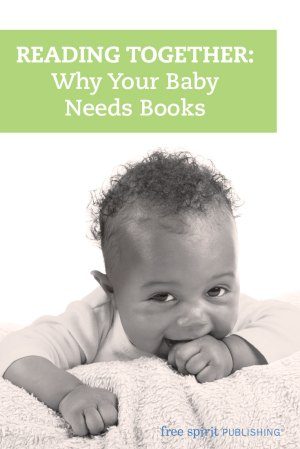 When you read to your baby, you’re not just bonding, you’re promoting language and social skills. It’s never too early to start a positive lifetime habit.
When you read to your baby, you’re not just bonding, you’re promoting language and social skills. It’s never too early to start a positive lifetime habit.
“In the first few weeks with my newborn at home, whatever I was reading, I would read aloud to my baby—novels, magazine articles, even emails. As she got older, I started adding in baby board books, and she seemed mesmerized by the pictures,” said new mother Sarah Fazio. “Now, at five months, we read a variety of children’s books, and I’m always surprised by how much it soothes her and holds her attention.”
It’s no surprise that babies are born ready to learn, and books can lead the way.
Born to Learn
Did you know that newborns can see in color? And that their eyes can track? Babies arrive ready to learn—and to be social. They love to observe, and they love the sound of your voice. No matter where you and your baby are—in a comfy chair, outside on a blanket, or on a bench in a busy mall—sharing a book together creates a private cocoon. Like feeding time or lullaby time, moments spent reading build deep connections between the two of you. From the very beginning, the more time you read with your baby, the more he will discover about himself and his world.
Babies Need Books
The American Academy of Pediatrics (AAP) confirms that reading with babies is critical for their healthy development. When you share a book with your baby, you’re supporting the amazing process of development that links baby’s senses of hearing, sight, and touch to build and strengthen listening skills, eye gaze and tracking, and hand-eye coordination. Babies benefit both from hearing you read and from joining in to talk and point at the pictures.
Books of All Kinds
Choose books that are sturdy and safe for mouthing. (The 2008 Consumer Product Safety Improvement Act—CPSIA—requires testing and documentation of books and other goods for children under 12.) Soft fabric books and chunky board books are best for infants and young babies; for older babies and toddlers, picture books in paperback or hardcover are equally good.
Share a simple board book and baby sees colors, shapes, and faces. Read a nursery rhyme and she hears rhythm, sing-song, and the highs and lows of your voice inflection. Offer a touch-and-feel book and baby reaches out to interact. Open to a shiny “mirror” on the page and baby sees . . . herself!
“When we read board books, my daughter is very engaged with the pictures, reaching forward as I pause on each page and sometimes read it twice,” Fazio explained. “When we read longer stories, she responds to the cadence of my voice with raised eyebrows or drool.”
Newborns will become curious or calmed, depending on the inflections of your voice as you read. Older babies will gradually understand stories and want to hear them again and again. Talk together about the pictures and ask questions: “What do you think the kitty’s name is?” “Look at that red ball. What color is your ball?”
Start a Reading Routine
The first year of life is a perfect time to begin a reading habit that can open up the world to your baby and set the stage for a lifelong love of reading, listening, and sharing through words and pictures. It’s true that your infant may not understand the words you read or recognize many of the pictures he sees, but the sound of your voice is stimulating for him. It helps him learn to listen and also to associate books with you—the center of his world—and with fun!
Younger babies like to touch, shake, reach, grab, and mouth things, so they may first explore books by chewing or throwing them. Soon, though, they’ll want to look at, touch, and talk about all they see and hear while reading. By the time they reach their first birthday, babies look forward to reading with you and will find their favorite book and name the pictures. Erica Laroche understands this all too well. At fifteen-and-a-half months, her son Lucas had fallen in love with Goodnight, Goodnight, Construction Site and wanted to hear it again and again and again. Occasionally, he’d let Mom choose something else.
Screens Are Not for Babies
What about reading on smartphones, e-readers, and tablets? The AAP strongly recommends no screen time for children under 18 months old (although parents don’t need to feel guilty about having conversations over Facetime or Skype to connect baby with faraway friends and relatives). Babies are attracted to the screens, of course! But experts link those bright, colorful, flashing screens to language learning delays. Babies’ brains are developing quickly, and what they need most is human interaction—especially with parents and other family members. You’ll be giving your baby, and yourself, a big gift if you turn off and put away your electronics during reading time—or any time you’re playing and talking with your baby.
The Joy of Reading
The rewards of reading together just keep multiplying. “The benefits of books are endless,” said Sarah Fazio. “Reading together is just the first step on a long road of reading.” Another mom, Eva Widder, echoed this sentiment in regard to her nine-month-old daughter. “Reading with my daughter is such a special part of our routine,” she explained. “It’s especially sweet to see her respond to the books: studying pictures of other babies, laughing at the sounds and voices I use, and helping turn the pages. It’s fun to imagine reading together when she’s a toddler, a young child, and even a teenager.”
Note: Reading with your baby means interacting and sharing the pleasure of books; it doesn’t mean teaching your baby to read. In fact, a growing body of expert research recommends against efforts to teach reading skills to babies. In the March/April 2015 issue of Exchange magazine, Dr. Bisa Batten Lewis offered a thoughtful and thorough look at ways to support early language and literacy growth without “teaching” reading. Check out an excerpt of the article, or buy the complete article at the ChildCareExchange website.
Books to Share with Babies
All of Baby, Nose to Toes by Victoria Adler, illustrated by Hiroe Nakata
Baby’s Colors, Peek-a-Baby, Where Is Baby’s Yummy Tummy? (and many other books) written and illustrated by Karen Katz
Everywhere Babies by Susan Meyers, illustrated by Marla Frazee
Here’s a Little Poem: A Very First Book of Poetry compiled by Jane Yolen and Andrew Fusek Peters, illustrated by Polly Dunbar
How Do I Love You? by Marion Dane Bauer, illustrated by Caroline Jayne Church
Pat the Bunny by Dorothy Kunhardt
The Real Mother Goose, illustrated by Blanche Fisher Wright
Check out Parents.com for their list of “The Best Books Age by Age: Babies” and “Building Baby’s First Library: 25 Must-Have Books.”
 Elizabeth Verdick has been writing books since 1997, the year her daughter was born. Her two children are the inspiration for nearly everything she writes. Before becoming an author, Elizabeth edited books for children and parents. These days she writes books for babies, toddlers, teens, and every age in between. She especially loves creating new board book series—including the Happy Healthy Baby® series, which is designed to capture the interest of your littlest readers. Elizabeth’s Toddler Tools® series helps young children and their parents cope with those tough times and transitions that happen every day (like naptime and bedtime). In the Best Behavior® series, she helps toddlers reach new milestones and improve their day-to-day behavior. Elizabeth also enjoys getting the chance to look at the funny side of life in the Laugh and Learn® series, which helps kids ages 8–13 get a handle on the social and emotional skills they’re developing throughout the elementary and middle school years. Elizabeth lives with her family and five pets near St. Paul, Minnesota.
Elizabeth Verdick has been writing books since 1997, the year her daughter was born. Her two children are the inspiration for nearly everything she writes. Before becoming an author, Elizabeth edited books for children and parents. These days she writes books for babies, toddlers, teens, and every age in between. She especially loves creating new board book series—including the Happy Healthy Baby® series, which is designed to capture the interest of your littlest readers. Elizabeth’s Toddler Tools® series helps young children and their parents cope with those tough times and transitions that happen every day (like naptime and bedtime). In the Best Behavior® series, she helps toddlers reach new milestones and improve their day-to-day behavior. Elizabeth also enjoys getting the chance to look at the funny side of life in the Laugh and Learn® series, which helps kids ages 8–13 get a handle on the social and emotional skills they’re developing throughout the elementary and middle school years. Elizabeth lives with her family and five pets near St. Paul, Minnesota.
 Marjorie Lisovskis has been writing and editing books for children, teachers, and parents for more than 30 years and has a special interest in creating books that help young children see themselves as confident, capable, and loved. Along with the Happy Healthy Baby series, she is the coauthor (with Elizabeth Verdick) of How to Take the Grrrr Out of Anger. Marjorie has two grown children and three grandchildren. She lives with her husband in Minneapolis, Minnesota.
Marjorie Lisovskis has been writing and editing books for children, teachers, and parents for more than 30 years and has a special interest in creating books that help young children see themselves as confident, capable, and loved. Along with the Happy Healthy Baby series, she is the coauthor (with Elizabeth Verdick) of How to Take the Grrrr Out of Anger. Marjorie has two grown children and three grandchildren. She lives with her husband in Minneapolis, Minnesota.
“Reading Together: Why Your Baby Needs Books” originally appeared at freespiritpublishingblog.com. Copyright © 2020 by Free Spirit Publishing. All rights reserved.

